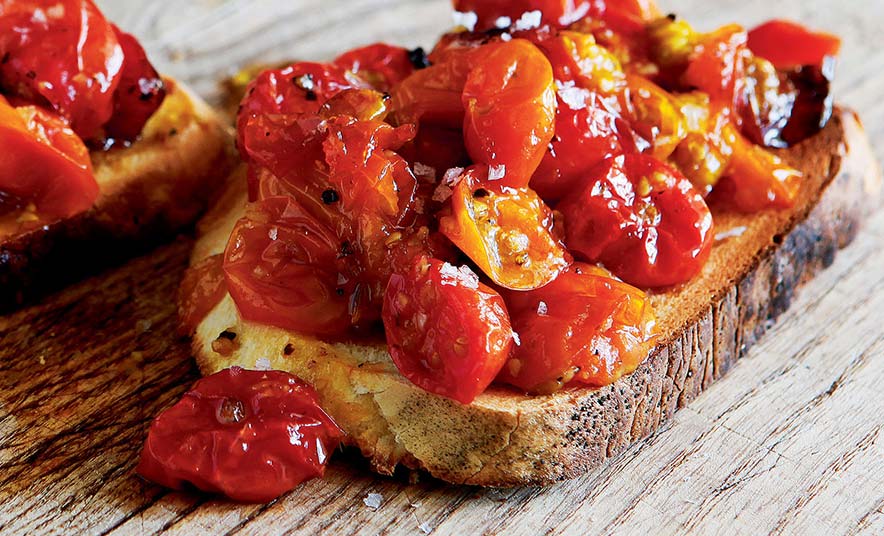Welcome to Modern Farmer's new harvest column, in which we highlight what is seasonal, talk to those who grow it, and share a recipe (or two). We start with one of our favorites, tomatoes.

Paul “Pablito” Underhill is a partner and farmer at Terra Firma Farm in Winters, California. The 200-acre certified organic farm sits 70 miles outside San Francisco, has a vibrant CSA community (serving 1,200 people) and harvests 20 acres and 30 varieties of tomatoes a year.
On his blog, Underhill writes: “Heirloom tomatoes may be a tomato-lover’s dream, but they are very close to being a farmer’s nightmare. We have spent almost twenty years growing them, and yet each year is like spinning a giant roulette wheel. Each year there are certain varieties that perform well, while others fail almost completely to produce. The next year, the varieties might flip-flop on their performance. While we generally understand the correlation with certain weather patterns — some varieties like cooler weather, others like it hot — there is absolutely nothing we have figured out to do about it.”
Modern Farmer: So you guys are big into tomatoes.
Paul Underhill: Tomatoes are our biggest wholesale crop. It’s our main focus in the summer. Everything else is a rotation crop.
We harvest mostly by hand. Tomatoes are an extremely labor intensive crop to grow. Depending on the variety, there are two main kinds ”“ determinate tomatoes, which grow like a bush, and indeterminate, which are a vine and have to be trellised. Most of our varieties are indeterminate: To grow those you have to tie them up as they grow. Those tomatoes take a huge amount of labor.
And then the harvesting and sorting is also done by hand, and is also extremely labor intensive. On an average summer day we have 30 people harvesting tomatoes, and another 15 sorting them. It takes a lot of people.
MF: How many pounds of tomatoes do you harvest in a day?
PU: We have 20 acres of tomatoes, but we’re not harvesting 20 acres at same time. The most we’re ever harvesting is 8 or 10 acres at a time. Off of that, it’s really ”“ well, now, I’ve never really sat down and figured it out! ”“ but something like 20,000 pounds in a day at the peak of our season. Cherry tomatoes aren’t measured by the pound, though. And they take 10 times as long to pick.
And then there’s the flip side of growing tomatoes, the days when you’re having people do a lot of walking and not getting any tomatoes at all. The same exact size field can go from producing 20,000 pounds of tomatoes one week to 5,000 pounds the next.
MF: What makes the difference?
PU: With tomatoes, it’s mostly the weather ”“ the weather effects tomatoes when they’re ripening, and if you have hot weather when setting fruit, the harvest is reduced. If it’s hot when harvesting, that accelerates the harvest. Summer tends to be like that for all tomato growers in the area. It goes in spurts. For a week or two everyone is going crazy, then a week or two sitting around wondering what happened to all the tomatoes. Tomato buyers are freaking out, too, because the week before they got 200 boxes, this week only 50.
MF: What’s the ideal weather for tomatoes?
PU: A mild spring. Not a wet spring. A normal spring — not too hot, not too cold, a Goldilocks-y kind of spring. And then a summer that is hot but not scorching. You want the nights not to get too cool. If nighttime temps are in 50s, it’s like putting tomatoes in a cooler every night, which keeps them from ripening. If nighttime temps are in the 80s, though, they ripen so fast you can’t keep up with them. We’ve had years like that. You can go through a month of tomatoes in 2 weeks.
MF: So tomatoes move fast?
PU: Your average supermarket tomato is picked green and then ripened with ethylene gas. We’re in the niche market of vine-ripened tomatoes, so we don’t pick tomatoes when they’re green, but you can’t pick one that’s ready to eat, either. If you pick a tomato that’s ready to eat, a perfect tomato to have on my sandwich, at 6am on Monday (which is when we begin harvesting), then by Tuesday middle of day it’s no longer usable. You can’t stop a tomato from ripening. You can slow it down or speed it up, but even though some farmers lie and tell people they got up at 3am to pick that very tomato they sold, they had to have picked the tomatoes at least the day before.
[mf_editorial_break layout=”twocol” title=”Honey-roasted cherry tomatoes” subtitle=”Recipe”]
Serves 4
1 pound / 500g cherry tomatoes
2 garlic cloves
1 tablespoon clear honey
3 tablespoons olive oil
Flaky sea salt and freshly ground black pepper
Preheat the oven to 375°F / 190°C. Lightly oil a roasting pan. Halve the tomatoes and place them, cut side up, in the dish. They should fit snugly with little or no space between them.
Crush the garlic with a pinch of salt, then beat it with the honey, olive oil, and a good grinding of pepper. Spoon this sticky, garlicky mixture over the cherry tomatoes. Roast for about 30 minutes, until golden, juicy, and bubbling.
[/mf_editorial_break]
Reprinted with permission from River Cottage Veg by Hugh Fearnley-Whittingstall, copyright (c) 2011. Published by TenSpeed Press, a division of Random House, Inc.
Photography (c) 2011 by Simon Wheeler